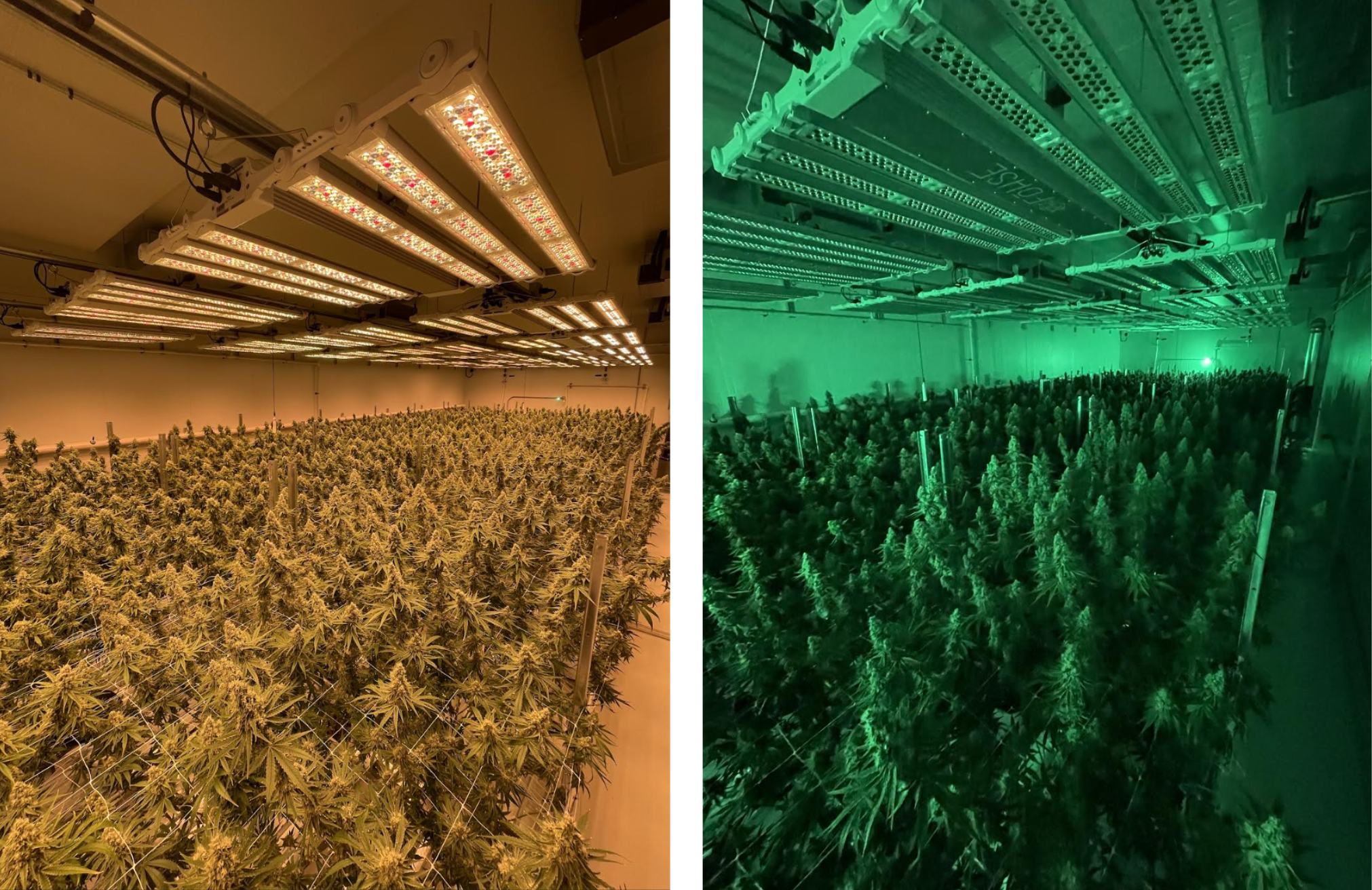The Importance of Hot Gas Reheat Dehumidification for Indoor Cannabis or Greenhouse Grow Facilities
In indoor or greenhouse cannabis cultivation, environmental control plays a pivotal role in optimizing plant growth and achieving high yields. Among the critical factors for a healthy growing environment are temperature, humidity, CO2, air movement, and light. While growers often focus on lighting and associated PPFD, or day and night temperature setpoints that optimize terpenes, humidity regulation is just as crucial for plant health but often overlooked and under budgeted.
One of the most effective and energy efficient ways to control humidity in an indoor grow room is through hot gas reheat dehumidification. Easy Roots has developed an HVAC-D system that controls temperature,

Understanding Hot Gas Reheat Dehumidification
Hot gas reheat dehumidification is a sophisticated HVAC-D process used to control both temperature and humidity levels in controlled environment agriculture (CEA). It involves the use of a refrigeration system to cool the air, followed by reheating the air to maintain the desired temperature. In a typical dehumidification process, moisture-laden air is passed over a cold evaporator coil, causing the moisture to condense into liquid water. The air is then reheated to the desired temperature before being circulated back into the grow space at a similar temperature and reduced humidity level.
This process is particularly useful in indoor or greenhouse cannabis cultivation because it enables growers to manage both temperature and humidity with ease, without requiring an additional power source for the reheating of the air. Mechanical and Electrical engineers must navigate electrical constraints common to most cultivation facilities, so reheat systems that require electric heat kits become untenable due to cost of power upgrades. Reheat systems that require natural gas or propane can add unnecessary cost to a buildout, while also adding unneeded humidity to the grow rooms that can cause condensation and mold.
Easy Root’s hot gas reheat dehumidification systems recover waste heat from the cooling process to power humidity control, giving Easy Root’s growers the upper hand as it relates to reduced costs and a superior grow environment.
Why Humidity Control is Crucial in Cannabis Growing
Cannabis plants are highly sensitive to fluctuations in humidity, especially during their flowering stage. The ideal relative humidity (RH) levels for cannabis plants range from 60-70% during the vegetative phase and 45-60% during flowering. Excessive humidity can lead to a number of issues, including mold and mildew growth, which can ruin crops and reduce yields.
Without proper humidity control, growers risk reduced plant health, slower growth, and a decline in quality and quantity of the harvest. Maintaining optimal humidity is therefore essential not only for preventing mold growth but also for ensuring that plants grow efficiently and reach their full potential.
The status quo for humidity control in cannabis cultivation for the last decade or so has been the use of standalone, or independent dehumidifiers. While the technology that drives these units has improved and their efficacy is proven, they produce a substantial amount of waste heat that increases growers required HVAC tonnage. Standalone units also require more power and maintenance issues over the long term.
Easy Roots has combined this humidity control functionality into the centralized VRF HVAC systems, for a lower cost and more effective means of combined temperature and humidity control.
The Role of Hot Gas Reheat in Dehumidification
The primary benefit of Easy Root’s hot gas reheat dehumidification lies in its ability to effectively control both temperature and humidity at the same time without additional power for the dehumidification cycle. Here’s how it helps improve the growing environment for cannabis:
- Precise Humidity Control Without Overcooling
Traditional dehumidifiers often struggle to maintain a consistent temperature or humidity when removing excess moisture from the air. After dehumidification, the air temperature typically increases because of the waste heat generated, which can be detrimental to cannabis growth. Cannabis plants require a specific temperature range to thrive—too many standalone dehumidifiers can cause stress to the plants and affect overall growth. Hot gas reheat ensures that the dehumidified air maintains the desired temperature, preventing temp spikes while still maintaining proper humidity levels. - Energy Efficiency
Hot gas reheat systems are energy-efficient compared to traditional air conditioning units or standalone dehumidifiers. Since the process reuses heat from the refrigeration cycle, less energy is needed to achieve the desired temperature and humidity levels. For large-scale indoor grow operations, this can result in significant cost savings while maintaining optimal growing conditions. Easy Roots customers have realized millions in savings related to scaling back power upgrades with a switch to reheat dehumidification systems. - Prevention of Mold and Mildew
Mold and mildew are some of the most common problems in indoor cannabis cultivation. Excessive humidity in grow rooms creates a breeding ground for these harmful fungi. Hot gas reheat dehumidification maintains precise humidity control, preventing conditions that promote mold growth. By reducing excess moisture in the air while keeping temperatures stable, it ensures a healthier and more productive environment for cannabis plants. - Enhanced Growth and Quality
Hot gas reheat dehumidification not only protects against mold but also enhances plant growth by optimizing environmental conditions. By maintaining stable, ideal humidity and temperature levels, plants can focus on healthy growth instead of dealing with environmental stress. Proper moisture levels in the air also ensure that plants’ stomata remain open, allowing for efficient transpiration and nutrient uptake, which ultimately translates to healthier plants with higher yields.
Additional Benefits of Hot Gas Reheat Dehumidification
- Consistent Environmental Control: Hot gas reheat provides a reliable method for maintaining a consistent environment, which is crucial for the health of cannabis plants. Variations in temperature and humidity can stress plants and hinder their ability to grow effectively. By maintaining steady environmental conditions, hot gas reheat systems promote healthier, more robust plants.
- Reduced Risk of Plant Stress: Environmental fluctuations, especially temperature and humidity spikes, can cause stress to cannabis plants, potentially affecting their development. Hot gas reheat dehumidification helps avoid these fluctuations, keeping conditions stable throughout the growth cycle.
- Faster Drying for Harvesting: During the drying phase, controlling humidity is just as important as during the vegetative and flowering stages. Hot gas reheat dehumidification helps ensure proper moisture levels for drying cannabis after harvest, leading to better-quality buds and more efficient curing.
Conclusion
In the world of indoor and greenhouse cannabis cultivation, maintaining an optimal environment is key to producing high-quality crops. Hot gas reheat dehumidification systems offer a sophisticated solution for controlling both temperature and humidity, ensuring that cannabis plants receive the best conditions for healthy growth, without breaking the bank or exceeding power limitations.
By preventing mold, optimizing plant health, reducing energy costs, and improving overall environmental control, hot gas reheat dehumidification is an indispensable tool for indoor and greenhouse cannabis growers striving for consistent, high-quality yields. With the right combined temperature and humidity management system in place, cannabis cultivators can ensure that their plants reach their full potential, resulting in a successful and profitable harvest.

